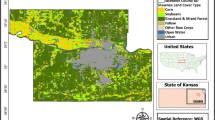Abstract
Solar irradiance is the most important factor which determines the thermal conditions of mountain glaciers. We use trigonometric formulae to calculate direct solar radiation incoming on any arbitrary oriented surface under the condition of absence of the atmosphere. Shading effect from the surrounding relief can also be evaluated rather precisely. Nevertheless, in order to obtain correct results, it is necessary to take into account atmospheric transmissivity, diffuse radiation, and influence of cloudiness. The paper presents a model for calculation of shortwave radiation, utilizing up-to-date data on the atmospheric composition and schemes for parameterization of the atmospheric transmissivity, which have never been implemented in glaciological applications before. Validation of the model was carried out using observational data on the global radiation on two weather stations established on Karabatkak glacier (Inner Tien Shan).




Similar content being viewed by others
REFERENCES
K. Ya. Kondratiev, Actinometry (Gidrometeoizdat, Leningrad, 1965) [in Russian].
K. Ya. Kondratiev, Z. I. Pivovarova, and M. P. Fedorova, Radiational Regime of Inclined Surfaces (Gidrometeoizdat, Leningrad, 1978) [in Russian].
S. S. Kutuzov, “Change in Area and Volume of Glaciers of the Terskey Ala-Too Ridge in the Second Half of the 20th Century,” Led i Sneg, No. 1, 52 (2012) [in Russian].
P. A. Morozova and O. O. Rybak, “Downscaling of the Global Climate Model Data for the Mass Balance Calculation of Mountain Glaciers,” Led i Sneg, No. 4, 57 (2017) [in Russian].
E. P. Rets, N. L. Frolova, and V. V. Popovnin, “Modelling of Melting on the Surface of the Mountain Glacier,” Led i Sneg, No. 4, 51 (2011) [in Russian].
O. O. Rybak, E. A. Rybak, N. A. Yaitskaya, et al., “Modeling the Evolution of Mountain Glaciers: A Case Study of Sary-Tor Glacier, Inner Tien Shan,” Kriosfera Zemli, No. 3, 23 (2019) [in Russian].
N. S. Arnold, W. Gareth Rees, A. J. Hodson, and J. Kohler, “Topographic Controls on the Surface Energy Balance of a High Arctic Valley Glacier,” J. Geophys. Res., 111 (2006).
J. L. Bamber and A. J. Payne, Mass Balance of the Cryosphere: Observations and Modelling of Contemporary and Future Changes (Cambridge University Press, Cambridge, 2004).
B. B. Chen, S. A. Imashev, L. G. Sverdlik, et al., “Ozone Variations over Central Tien Shan in Central Asia and Implications for Regional Emissions Reduction Strategies,” Aerosol and Air Quality Res., 13 (2013).
J. Dozier and J. Frew, “Rapid Calculation of Terrain Parameters for Radiation Modeling from Digital Elevation Data,” IEEE Trans. Geosci. and Remote Sens., 28 (1990).
C. A. Gueymard, “Direct Solar Transmittance and Irradiance Predictions with Broadband Models. Part I: Detailed Theoretical Performance Assessment,” Solar Energy, 74 (2003).
M. Iqbal, An Introduction to Solar Radiation (Academic Press, Toronto, 1983).
H. D. Kambezidis, B. E. Psiloglou, D. Karagiannis, et al., “Meteorological Radiation Model (MRM v6.1): Improvements in Diffuse Radiation Estimates and a New Approach for Implementation of Cloud Products,” Renewable and Sustainable Energy Rev., 74 (2017).
H. D. Kambezidis, B. E. Psiloglou, D. Karagiannis, et al., “Recent Improvements of the Meteorological Radiation Model for Solar Irradiance Estimates under All-sky Conditions,” Renewable Energy, 93 (2016).
D. G. Kaskaoutis and H. D. Kambezidis, “The Choice of the Most Appropriate Aerosol Model in a Radiative Transfer Code,” Solar Energy, 82 (2008).
E. J. Klok and J. Oerlemans, “Model Study of the Spatial Distribution of the Energy and Mass Balance of Morteratschgletscher, Switzerland,” J. Glaciol., No. 163, 48 (2002).
Y. Matsuda, K. Fujita, Y. Ageta, and A. Sakai, “Estimation of Atmospheric Transmissivity of Solar Radiation from Precipitation in the Himalaya and the Tibetan Plateau,” Ann. Glaciol., 43 (2006).
J. Nemec, P. Huybrechts, O. Rybak, and J. Oerlemans, “Reconstruction of the Surface Mass Balance of Morteratschgletscher since 1865,” Ann. Glaciol., 50 (2009).
S. Niemela, P. Raisanen, and H. Savijarvi, “Comparison of Surface Radiative Flux Parameterizations. Part II. Shortwave Radiation,” Atmos. Res., 58 (2001).
F. Pellicciotti, B. W. Brock, U. Strasser, et al., “An Enhanced Temperature-index Glacier Melt Model Including Shortwave Radiation Balance: Development and Testing for Haut Glacier d’Arolla, Switzerland,” J. Glaciol., 51 (2005).
F. Pellicciotti, T. Raschle, T. Huirlimann T., et al., “Transmission of Solar Radiation through Clouds on Melting Glaciers: A Comparison of Parameterizations and Their Impact on Melt Modelling,” J. Glaciol., 57 (2011).
B. E. Psiloglou, M. Santamouris, and D. N. Asimakopoulos, “Atmospheric Broadband Model for Computation of Solar Radiation at the Earth’s Surface. Application to Mediterranean Climate,” Pure and Appl. Geophys., 157 (2000).
S. Ragettli, F. Pellicciotti, R. Bordoy, and W. W. Immerzeel, “Sources of Uncertainty in Modeling the Glaciohydrological Response of a Karakoram Watershed to Climate Change,” Water Resour. Res., 49 (2013).
G. H. Yordanov, O.-M. Midtgard, T. O. Saetre, et al., “Overirradiance (Cloud Enhancement) Events at High Latitudes,” IEEE J. Photovoltaics, 3 (2013).
J. Zhang, K. Watanabe, J. Yoshino, et al., “Physical Process and Statistical Properties of Solar Irradiance Enhancement Observed under Clouds,” Japan. J. Appl. Phys., 57 (2018).
Author information
Authors and Affiliations
Corresponding author
Additional information
Translated from Meteorologiya i Gidrologiya, 2021, No. 8, pp. 5-20. https://doi.org/10.52002/0130-2906-2021-8-5-20.
About this article
Cite this article
Rybak, O.O., Satylkanov, R., Rybak, E.A. et al. Parameterization of Shortwave Solar Radiation in Glaciological Applications. Russ. Meteorol. Hydrol. 46, 495–506 (2021). https://doi.org/10.3103/S106837392108001X
Received:
Revised:
Accepted:
Published:
Issue Date:
DOI: https://doi.org/10.3103/S106837392108001X




